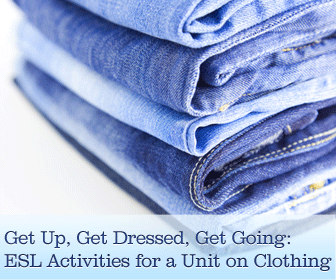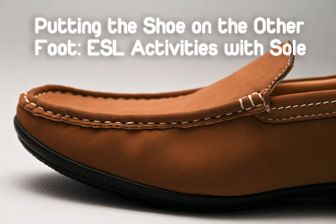Get Up, Get Dressed, Get Going: ESL Activities for a Unit on Clothing


Another year has rolled around and it is time once again for a unit on clothing. You have reviewed the vocabulary and practiced the typical role-plays. Your students know about the difference between a button down shirt and a blouse as well as socks and stockings. You have reviewed accessories from head to foot, but you are still looking for something different to do with your students. Yes, the topic is clothing and accessories, but is there not something different you can use to educate and inspire your students? The answer is yes. For those not so typical clothing and accessories lessons, try one of the following activities with sole.

Regional Language
Do you wear trainers? How about tennis shoes? Or are you someone who prefers sneakers? The truth is, all of these words describe the same things. The difference between them is not with the product but with the speaker. These three different words all of which are used for athletic shoes are just one example of the regional differences between speakers of English. Introduce the idea of regional language differences to your students by using this example, and then ask if they are aware of any other examples of regional vocabulary differences. If your class is able to offer any, write them on the board and discuss them with your class. Then you may want to add some of your own examples. You can include the set of words which refer to a long sandwich (hoagie, hero, grinder, torpedo and submarine) as well as any others that come to mind. Probably the most popular word choice controversy centers around the pop versus soda versus coke debate. In fact, there is an entire web page dedicated to the topic. If you have the resources and the time, encourage your students to explore the web page and then write a reaction to what they found there.
If you want to take the idea a step further, the 1988 documentary American Tongues explores several regional differences in English throughout the United States. Though the documentary in its entirety may be difficult to get a hold of, there are several clips available on YouTube.com that you may want to show your students. After viewing the clips which show how different areas of the country speak, encourage a discussion among your students about this phenomenon. How might these regional differences influence each of your student’s ability to communicate in English? How does it make them feel knowing that such differences exist in just one country? What are some strategies that your students can use if they find themselves in such a situation? Encourage honest expression throughout the discussion.
What a Shoe is Good For
If you were to ask your students what shoes are good for, you would probably get one answer: to wear on your feet. Surprisingly, though, shoes have far more uses than just foot protection. Give your students a chance to read what http://sneakers.pair.com/offlabel.htm has to say about unusual uses for shoes. Some information that the site has to offer may be expected, but others may seem very out of the ordinary. Encourage your students to let their imaginations run wild by thinking up some additional unusual uses for shoes. Could they be used for potted plants? How about using shoes as a means to drink champagne in a wild celebration? Have groups of about four or five students work together to make a list of as many unusual uses for shoes as they can think of. Then have each group choose one of their ideas and present it to the class in a creative way. They may want to write and perform a skit, a song or some other method of delivery. You can close out the activity with a clip from Get Smart in which the hero has a telephone hidden in his shoe.
What Do We Really Need
In 1776 during the American Revolutionary War, the leaders of the revolutionary forces told the Continental Congress that there were only nine hundred pairs of shoes for more than twelve thousand soldiers. This message was delivered at the beginning of December when soldiers were facing a long winter of war ahead of them. With this in mind, ask your students what people really need in order to survive. What can they personally not live without? What would they do if they did not have the basic necessities of clothing and shelter? Give your students some time in small group conversation to talk about what they really need to live from day to day. After the discussion, ask each person to make his own list of the top ten items he needs to survive. Most people will probably include items like clothing and shelter, but what other things does each person think she needs to survive? An internet connection? Music? Relationships? You may be surprised at what your students think they cannot live without. If you like, post each student’s list on a bulletin board titled “All We Need Is…” You may also choose to share the Beetles song “All You Need is Love” with your students. Give each person a copy of the lyrics to read as he listens to the song. Then ask each person to share with a partner whether he agrees or disagrees with the famous song.
These activities will challenge their understanding of language, survival and everyday life as each person thinks about bigger issues associated with his foot coverings. When you do, each person in your class will walk the road of discovery though these activities!